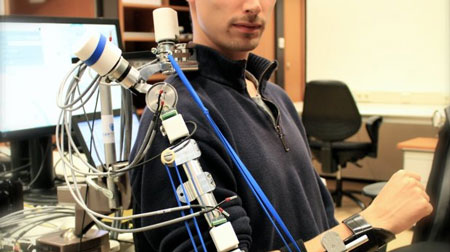Researchers in the Netherlands have developed a robotic arm that improves the lives of people with Duchenne Muscular Dystrophy.
The A-Gear robotic arm is the result of development work by a team of people from 4 different universities; the University of Twente’s MIRA research centre, the VU University Medical Centre Amsterdam, Delft University of Technology and Radboud University Medical Centre. It is the first prototype that can support independent operation of the arm whilst still being discreet and body connected. The A-Gear can easily be worn under clothing and so there is less stigma attached to its use.
Duchenne muscular dystrophy is a rare degenerative disease that affects the muscles of young boys and they eventually lose the use of their arms. Medical research means there are now medicines that can slow the progress of the disease and extend life expectancy, which in turn makes it even more important to find a way to preserve arm function.
The A-Gear is part of a wider set of projects being run by Flextension which was initiated by the Dutch Duchenne Parent Project to use engineering and technology to find solutions to help people living with Duchenne. Flextension’s goal is to develop supportive devices to improve the quality of life of people with Duchenne.
The A-Gear project has been running for 4 years and is working on two arm supports;
- a passive arm support which is controlled by the user, without motors and intended for use by people who are still able to move their arms themselves
- an active arm support, powered by motors controlled by the user; intended for use by people further along who cannot move their arms themselves. Electrical muscles signals control the active arm support making the movement as natural as possible.
The team studied arm function in patients of different ages allowing them to assess how much the arm function changes with the progression of the illness. This in turn allows them to see how the arm support needs to change and adjust over time. Work went on assessing the functionality both with the use of the A-Gear and without. For some patients, using the A-Gear arm support meant that they were able to use their arms independently for the first time years, completing a series of tasks. The functionality and movement the device provides also means that it requires less energy for patients to make those movements.
Their projects do not just concentrate on the engineering and mechanics of aids, but also on the importance of the size, structure and flexibility of aids. For instance, the ShellMEch project is involved in research and development into flexible shell structures. Thin curved material bodies commonly used in the aerospace sector are being applied to develop the discreet mechanisms that can be hidden beneath clothes.
The developments and achievements are encouraging but there is still some way to go. A review is currently underway to work the next steps in taking the prototype and turning it into a product that can be used effectively.
View the video about the Flextension progamme and the importance of the robotic arm below.


Recent Comments